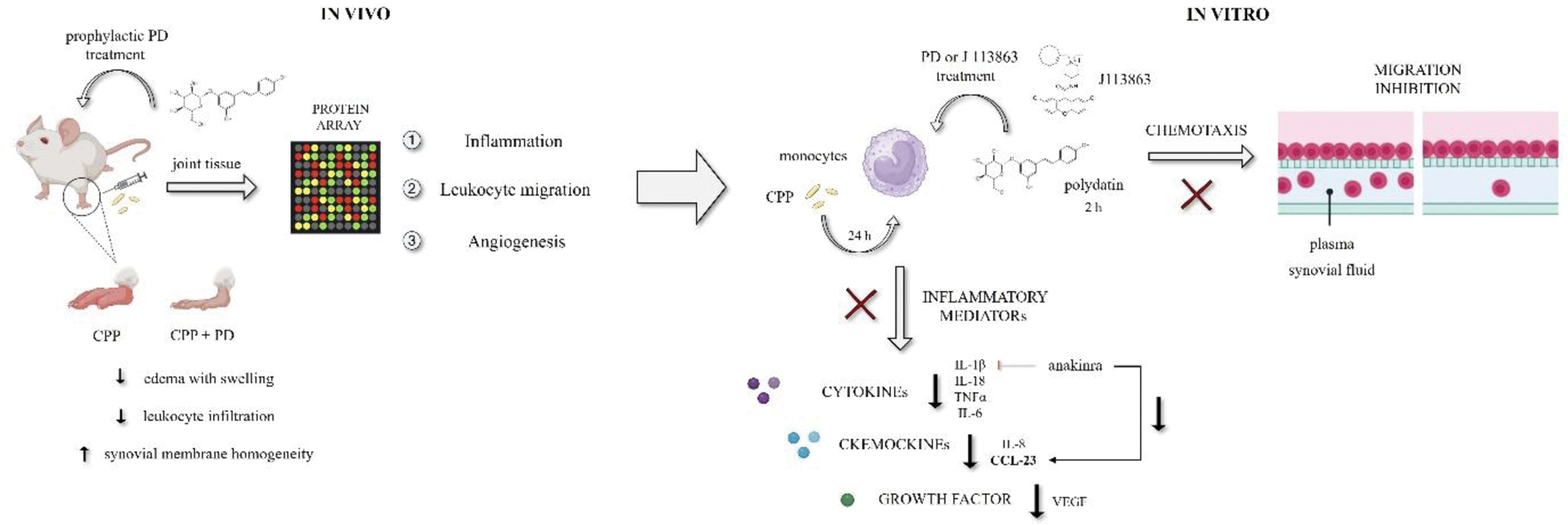

Background: The health benefits of polyphenols have garnered significant attention in the scientific community. We have recently shown that polydatin (PD) prevents calcium pyrophosphate (CPP) crystal-induced arthritis in mice. This study aims to explore some potential mechanisms of action associated with this anti-inflammatory effect.
Objectives: This study aims to explore potential mechanisms of PD action associated with this anti-inflammatory effect.
Methods: Both in vivo and in vitro models were employed. Acute arthritis was induced in mice by the injection of a suspension of sterile CPP crystals into the ankle joint of Balb/c mice. Animals were randomised to receive PD or colchicine (control drug) according to a prophylactic protocol. Ankle swelling was measured at various times before and after CPP injection. Both joints and muscles were harvested at sacrifice. Histological evaluations were performed using H&E staining to assess cartilage and muscle damage. Kondziela’s inverted test was used to assess muscle strength. An exploratory protein array was performed on joint tissue to identify relevant inflammatory pathways. Human monocytes pretreated with PD were stimulated with CPP crystals. Anakinra and J-113863 were used to assess their anti-inflammatory effect, while EX527 served to evaluate the effect of PD on SIRT-1. The chemotaxis assay to test the effect of PD and J-113863 on PBMCs migration in response to plasma and synovial fluids was performed in the Boyden chamber. Finally, cytokine levels (IL-1β, IL-18, IL-6, TNFα, IL-8, CCL-23 and VEGF) were measured by ELISA.
Results: CPP crystals injection resulted in swelling, leukocyte infiltration, loss of synovial membrane structure homogeneity. Mice pretreated with PD showed reduced ankle swelling and this was associated with very limited inflammatory damage. Regarding the effect on gastrocnemius muscle, crystals induced leukocyte infiltration and edema. PD and colchicine treatment reduced muscle damage and preserved musculoskeletal structure in mice. The cytokine array showed the activation of different inflammatory pathways after CPP injection and PD was shown to strongly influence leukocyte migration, angiogenesis and inflammation. In vitro, PD reduced the levels of IL-1β, IL-18, IL-6, TNFα, IL-8, CCL-23 and VEGF. CCR-1 inhibition was effective in reducing pro-inflammatory mediator levels in monocytes after CPP treatment and in reducing PBMCs migration. The anti-inflammatory action of PD also involved SIRT-1 activation, and its inhibition reverted the beneficial effects of PD. Finally, PD reduced the PBMCs migration in response to plasma and synovial fluids.
Conclusion: PD effectively prevents acute inflammatory responses to CPP crystals in mice, preserving both articular and muscular structures. Its anti-inflammatory effects are primarily mediated through pathways regulating leukocyte migration and the suppression of pro-inflammatory mediator.

REFERENCES: NIL.
Acknowledgements: NIL.
Disclosure of Interests: None declared.
© The Authors 2025. This abstract is an open access article published in Annals of Rheumatic Diseases under the CC BY-NC-ND license (